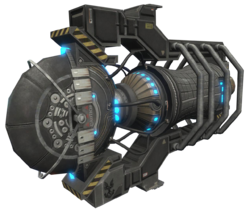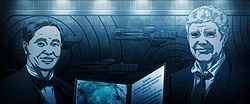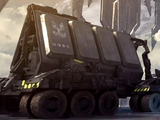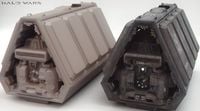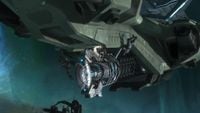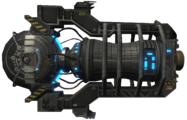Shaw-Fujikawa Translight Engine
From Halopedia, the Halo wiki
- "They have opened a path to the stars for all of us."
- — Dedication to Tobias Fleming Shaw, ScD, QeD, FRS (January 30, 2220–November 10, 2317), and Wallace Fujikawa ScD, QEnD (April 20, 2215–February 18, 2318)[1]
The Shaw-Fujikawa Translight Engine (SFTE), Shaw-Fujikawa drive and FTL drive, is a type of slipspace drive created by humans. It is a spacecraft propulsion system that is capable of making transitions to and from slipstream space, and by extension allowing faster-than-light interstellar travel.
History
The engine was developed in secret by a group of engineers and theoretical physicists led by Tobias Fleming Shaw and Wallace Fujikawa and once complete, was unveiled in April 2291.[1][2] From that point onward, the drive became one of the most important technological innovations of humanity.[3] The drive is not without limitations, however, although these may be partially because of slipstream physics rather than engineering imperfections.
By 2552, a vast majority of large human spacecraft of sufficient size were equipped with a slipspace engine, including most, if not all of the UNSC Navy's warships. Throughout much of humanity's colonial era and the Human-Covenant War, the technology was still limited and jumps typically took from several weeks to months, with longer jumps taking over half a year.[3] By the end of the war, human advances in science and engineering, as well as captured Forerunner technology allowed for the construction of slipspace drives almost on par with those of the Covenant.[4] The UNSC Infinity was capable of making slipspace transitions within an accuracy of one kilometer, and within one second of expected arrival time.[5]
Design details
Functionality
The Shaw-Fujikawa Translight Engine functions by creating ruptures, referred to in some sources as wormholes, between normal space and an alternate plane known as slipspace (also known as slipstream space and Shaw-Fujikawa space).[6] The engine creates ruptures by using high-power cyclic particle accelerators to generate microscopic black holes. Because of their low mass, Hawking radiation gives them a lifetime of around a nanosecond (or potentially a little longer than a whole second)[7] before they evaporate into useless thermal energy. In that nanosecond, the engine manipulates them into forming a coherent rupture between normal space and the slipstream.[8] A major component of the drive is a set of "slipspace capacitors" which have to be charged before a jump, presumably to accumulate enough power to run its particle accelerator.[9][10] This process can take hours or days to complete[11] or can take 18 minutes or less for a military warship[12][Note 1] and uses a ship's fusion or antimatter reactors.
The Shaw-Fujikawa Translight Engine generates a quantum field, which prevents the ship and its occupants from being directly exposed to the eleven-dimensional space-time of slipspace, instead translating the ship's presence to the foreign physics of the Slipstream and "squeezing" it through the higher dimensions.[13] Maintaining the quantum field requires an enormous amount of constant calculations, with larger vessels requiring significantly more such calculations than smaller ones. For example, the slipspace translations for a Phoenix-class colony ship require 4.3 quadrillion calculations of the quantum field per second.[14]
A human slipspace drive does not actually "accelerate" a spacecraft through slipstream space; this is performed by the ship's conventional reaction thrusters. Thus, ships with more powerful conventional engines are also faster within the slipstream.[15] When active, a Shaw-Fujikawa engine emits alpha (helium nuclei) and beta particles (fast electrons).[16] The coordination and plotting of slipspace jumps, referred to as astrogation, requires an enormous amount of calculations which require a navigation computer or an AI to successfully conduct.[17] However, the basic jump parameters can be calculated by a human.[18]
The elements Selenium and Technetium are used to manufacture Shaw-Fujikawa Translight Engines.[19]
Dangers and risks
Human slipspace drives are considered black boxes which are very difficult to repair or maintain after they are activated for the first time. Kurt-051 considered slipspace drives dangerous, noting the aforementioned radiation and that spacetime was said to distort around an active device.[8] Dr. Halsey also observed that in the past, several technicians had simply vanished while manually adjusting a drive. However, such adjustments were still often necessary by the late 25th century, as the superconducting magnets that aligned the drive's acceleration coils tended to drift out of phase and the electronic systems designed to control them often malfunctioned in proximity of the drive core due to exposure the warped laws of physics around the device.[20]
A ruptured slipspace drive can create slipspace "splinters" in normal space, eventually consuming the drive and the entire ship which the drive was placed on.[21] Mechanical failures like Slip Termination, Preventable, or STP, can also occur with Slipspace drives, usually resulting from poor maintenance.[3] An improperly mounted Slipspace drive can also result in catastrophic accidents. This was the case with a colony ship en route to the Cygnus system around 2550: as a result of a maintenance failure, the drive transported half the ship into oblivion, killing 700.[22]
When a similar slipspace rupture was induced by Jorge-052 to destroy the Long Night of Solace in the orbit of Reach, it created an EMP effect that disabled all satellites within its range.[22]
Model types
CODEN series
The term "CODEN" originated as Doctor Wallace Fujikawa's cryptic name for the physics package installed at the core of the first Shaw-Fujikawa Translight Engine. Overtime, the term has come to refer to the field generators of any SFTE, with major improvements denoted by a series number.[23] The Series III was installed in Phoenix-class colony ships,[24] while the Series IV was common in frigates and destroyers, including Stalwart-class light frigates,[25] Charon-class light frigates,[26] and Diligence-class light destroyers.[27] The Series V was installed on the Halcyon-class light cruiser UNSC Pillar of Autumn before it was deployed for its final operation.[28] Covenant slipspace drives were approximately equivalent to CODEN Series VI.[29]
Macedon
The first in its own class, the UNSC Infinity is equipped with the Mark X Macedon/Z-PROTOTYPE #78720HDS.[26] This engine is Forerunner in origin and design.[30]
Saddle box
Saddle boxes are rare, specialized slipspace drives built only by the UNSC for use in military experiments with slipstream space. They are commonly built to resemble commercial slipspace drives in order to be inconspicuous.[31]
Known models
Series III CODEN
- OKB Karman 11E: Manufactured by OKB Karman, this Series III CODEN was installed on the Phoenix-class colony ship UNSC Spirit of Fire.[24]
- Kawanishi Engineering SED-2450: Manufactured by Kawanishi Engineering, this Series III CODEN was installed on Able-class heavy destroyers.[32]
Series IV CODEN
- Starwerx FTL-290C: Manufactured by Starwerx, this Series IV CODEN was installed on the Stalwart-class light frigate UNSC In Amber Clad.[33]
Series V CODEN
- Kawanishi Engineering SED-2550X: Manufactured by Kawanishi Engineering, this Series V CODEN was installed on the Halcyon-class light cruiser UNSC Pillar of Autumn before it was deployed for its final operation.[28][34]
Atypical uses
There have been several occasions where a Shaw-Fujikawa Translight Engine has been used for purposes other than those intended.
Experimental transitions
The UNSC has twice attempted to execute under-powered slipspace transitions. They were both unsuccessful, leading to the conversion of the trial spacecraft into “atomized bits”.[35] In 2547, Dr. Catherine Halsey used the slipspace drive of the UNSC frigate UNSC Tripping Light to conduct an experiment on building an abstract fractal within slipspace for AI housing.[36][37]
Although two human ships utilizing the Shaw-Fujikawa engine are suspected of having successfully executed an in-atmosphere slipspace transition, this has not been irrefutably confirmed.[38][39]
During her journey to Onyx, Dr. Halsey performed a risky manual adjustment on the drive of Beatrice through a minute turn of one of the drive's supercooled superconducting magnets, resulting in a 32-percent increase in coil power.[20] She was also able to recapture the particle accelerator energy in the ship's plasma coils by plotting the exit vector through a saddle point (a point on the surface of the graph of a function where the slopes (derivatives) in orthogonal directions are all zero (a critical point), but which is not a local extremum of the function) in the mathematical function representing the jump trajectory, although there was a risk of coil overload involved.[40]
Weaponized uses
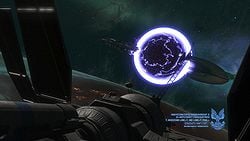
Slipspace drives may also be used as improvised, if highly expensive, weapons of mass destruction. By momentarily generating an uncontrolled slipspace rupture within a kilometers-wide radius, the device forcibly transitions any matter in the affected area into slipspace.[22] Projections of the Insurrection's escalation into a major war suggested that with unrestricted access to slipspace-capable craft, any hostile colony would turn them into weapons against Earth.[41]
In 2531, the UNSC Spirit of Fire reused the nuclear reactor from its slipspace drive as an improvised bomb, in order to induce a supernova in the miniature star at the heart of Trove. Sergeant John Forge was forced to stay behind and detonate it manually due to damage to it and the improvised bomb worked perfectly, destroying the shield world after the Spirit of Fire escaped.[42][43] In the same year, the Office of Naval Intelligence used a partially deconstructed drive to cause Kurt-051's thruster pack to malfunction and send him flying into space so he could be secretly rescued and recruited into the SPARTAN-III program.[8]
During the Fall of Reach in 2552, remembering an accident involving an improperly-mounted slipspace drive, Spartan-III Catherine-B320 of Noble Team devised a plan to use the UNSC Savannah's slipspace drive as an improvised "bomb" to destroy the Covenant Sh'wada-pattern supercarrier Long Night of Solace, in lieu of nuclear weaponry, which was unavailable at the time. The bomb was transported by a Pelican into the hangar bay of the Ceudar-pattern heavy corvette Ardent Prayer, which was then hijacked and set on a refueling track with the supercarrier. The activation timer for the "bomb" was damaged in a firefight, so Jorge-052 stayed behind to activate it manually, while SPARTAN-B312 was forced out of the ship. When the slipspace drive was activated, a massive slipspace rupture was created, which caused Ardent Prayer, along with a large portion of Long Night of Solace, to be teleported into oblivion. With its entire midsection missing, the remains of Long Night of Solace crashed onto the surface of the planet Reach.[22]
Trivia
- The slipspace technology name Shaw-Fujikawa may have been another aspect of the inspiration Bungie derived from the sci-fi movie Aliens in which a prominent company in that film was a combination of the hyphened western and Asian surnames, Weyland-Yutani.
- In real-world physics, black holes have been identified as a possible vector for constructing traversable wormholes, specifically through the use of the Kerr metric.
Gallery
The UNSC Spirit of Fire transitioning through slipspace. It should be noted that this depiction of slipspace is artistic license; canonically, slipspace appears as a pitch black void.
Concept art of the UNSC Savannah's slipspace drive.
The slipspace drive of the UNSC Kronstadt as shown in Halo: Warfleet.

|
Browse more images in this article's gallery page. |
List of appearances
|
|
Note
- ^ The UNSC Dusk had 15 minutes of stealth after leaving slipspace and used that time to setup an ambush as well as charge their slipspace capacitors. It took 9 minutes, or 6 minutes of stealth remaining, to charge the capacitors to 50%, when the captain ordered that engine power be rerouted to charge the capacitors faster. This means that with standard stealth maneuvering, the Dusk would have recharged their slipspace capacitors in 18 minutes, or 12 minutes if they reroute extra power to charge.
Sources
- ^ a b Halo 3, multiplayer level Orbital
- ^ Halo Encyclopedia, page 43 (2011)
- ^ a b c Halo: Contact Harvest, page 24
- ^ Halo: Glasslands, page 68
- ^ Halo: The Thursday War, page 247
- ^ Halo: The Fall of Reach, page 141
- ^ FoxNews: Scientists Not So Sure 'Doomsday Machine' Won't Destroy World
- ^ a b c Halo: Ghosts of Onyx, page 53
- ^ Halo: First Strike, page 192 (2003 edition)
- ^ Halo: Ghosts of Onyx, pages 295, 376
- ^ Halo: Warfleet, page 14
- ^ Halo: Ghosts of Onyx, chapter 32
- ^ Dr. Halsey's personal journal, December 25, 2534
- ^ Halo Wars: Genesis
- ^ Halo: Contact Harvest, page 23
- ^ Halo: Ghost of Onyx, pages 145-146
- ^ Halo: Contact Harvest, page 96
- ^ Halo: Evolutions - Essential Tales of the Halo Universe, "The Impossible Life and the Possible Death of Preston J. Cole", page 426
- ^ Halo: Evolutions - Essential Tales of the Halo Universe, "The Impossible Life and the Possible Death of Preston J. Cole", page 436
- ^ a b Halo: Ghosts of Onyx, page 145-146
- ^ Halo: Evolutions - Essential Tales of the Halo Universe - The Mona Lisa, page 332
- ^ a b c d Halo: Reach, campaign level Long Night of Solace
- ^ Halo: Warfleet, p. 90
- ^ a b Halo: Warfleet, p. 49
- ^ Halo: Warfleet, p. 37
- ^ a b Waypoint: The Halo Bulletin: 10.10.12
- ^ Halo: Warfleet, p. 10
- ^ a b Halo Waypoint: Data Drop 5
- ^ Halo: Warfleet, p. 77
- ^ Spartan Ops, S1E3 Catherine
- ^ Halo: First Strike (2010), Tug o' War
- ^ Halo Waypoint, Canon Fodder - Digsite Dissection (Retrieved on Jul 28, 2023) [archive]
- ^ Halo: Warfleet, p. 36-37
- ^ Halo: Warfleet, p. 25
- ^ Halo: Ghosts of Onyx, page 225
- ^ Dr. Halsey's personal journal, September 4, 2547
- ^ Halo: Reach, Data pad 17
- ^ Halo: Evolutions - Essential Tales of the Halo Universe - The Impossible Life and the Possible Death of Preston J. Cole, page 474
- ^ Halo: Evolutions - Essential Tales of the Halo Universe - The Impossible Life and the Possible Death of Preston J. Cole, pages 484-485
- ^ Halo: Ghosts of Onyx, page 152
- ^ Dr. Halsey's personal journal, December 4, 2510
- ^ Halo Wars, campaign level Reactor
- ^ Halo Wars, campaign level Escape
